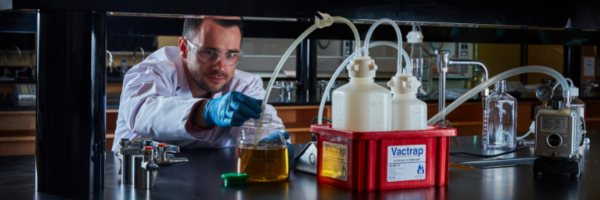
Did you ever walk into a laboratory and notice a vacuum flask being used as a Trap for a Vacuum pump?
Most are pretty gross with mystery matter growing inside.
According to the most Recent CDC guidelines (40 CFR 264.15) for Vacuum fluid transfer of biohazard products:
“Aspirator bottles or suction flasks should be connected to an overflow collection flask containing appropriate disinfectant and to an in-line HEPA or equivalent filter. Commercial equivalents are acceptable once validated for specific laboratory use. This combination will provide protection to the central building vacuum system or vacuum pump, as well as to the personnel who service this equipment. Inactivation of aspirated materials can be accomplished by placing a volume of a chemical decontamination solution having a concentration of chemical sufficient to decontaminate microorganisms when the flask is filled to its maximum capacity into the flask to inactivate the microorganisms as they are collected. Once inactivation occurs, liquid materials can be disposed of as noninfectious waste. The flask material should be resistant to the decontamination solution used”
Operations within Class II BSC guidelines require a secondary container, an In-line Hydrophobic HEPA filter between the overflow bottle with a decontamination solution and the vacuum pump.
40 CFR 264.15 compliant Vacuum Trap Solution
All of Foxx Life Sciences' Vactrap™ dual units have been validated and are 40 CFR 264.15 compliant. The Systems are Plug & Play vacuum traps, which are Ideal for the protection of vacuum pumps, vacuum lines, and scientists. The Vactrap™ Systems safely contains waste from supernatant removal, chemical separation, and cell or tissue culture media aspiration. The Vactrap™ Systems come ready to use; simply attach to your vacuum and begin your work.
Vactrap™ dual systems are CDC compliant, have a 0.22µm Hydrophobic Vent filter, TPE tubing and a pinch clamp for flow control as well as a secondary container.
Single Bottle Vactrap™ systems have a 0.22µm Hydrophobic Vent filter, TPE tubing and a pinch clamp for flow control and with or without a secondary container.
Four Vactrap™ configurations are available:
Vactrap™ 2 either HDPE Bleach compatible bottles or Autoclavable Polypropylene with 2 configurations, 1Liter + 1 Liter, & 2Liters + 1 Liter.
Vactrap™ Round Autoclavable Polypropylene with 2 configurations; 1Liter + 1 Liter, 2Liters + 1 Liter
Vactrap™ XL, either HDPE Bleach compatible bottles or Autoclavable Polypropylene with 3 configurations; 4 Liters + 1Liters, 4 Liters + 2 Liters, & 4 Liters + 4 Liters
Vactrap™ G, 3.3 Borosilicate Glass with 7 configurations; 1Liter + 1 Liter, 2Liters + 1 Liter, 2 Liters + 2 Liters, 3 Liters + 1 Liter, 5 Liters + 2 Liters, 10 Liters + 2 Liters, & 20 Liters + 5
Foxx Life Sciences’ Vactrap™ 2 is the world’s most advanced vacuum trap system, adhering to the strictest CDC recommendations for laboratory safety. Ideal for protecting vacuum lines and users, Vactrap™ 2 safely contains waste produced during supernatant removal, chemical separation, and cell/tissue culture media aspiration.